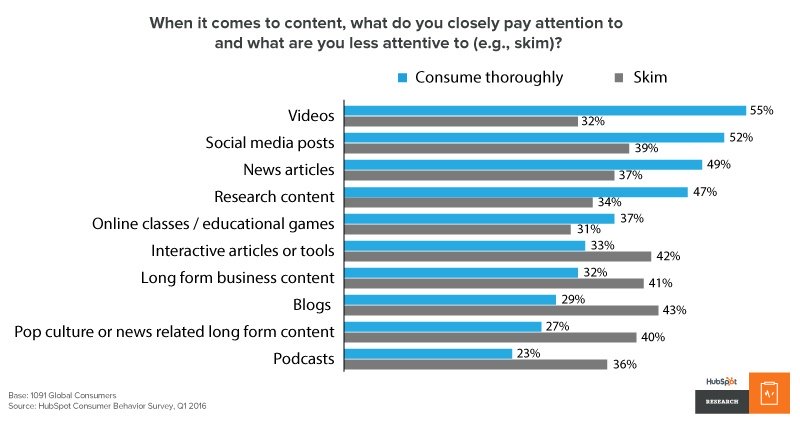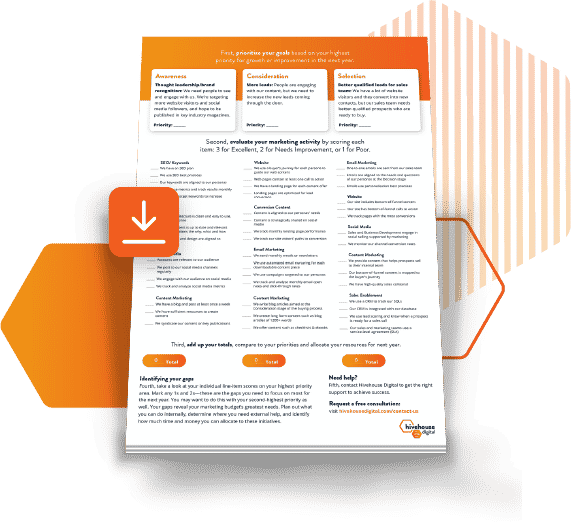
This article was updated on 11/7/22.
With the end of the year rapidly approaching, it’s time to start planning your company’s marketing and sales budget. As you continue with your planning process, here are four trends that could have a great effect on your marketing efforts. These trends no doubt will also influence how you perform your marketing strategies.
1) The Content, It Is a-Changin’
Blogs, white papers, and case studies will still work their magic, yet we may be in another major shift when it comes to how you will deliver the information your prospects demand: video content, mobile-friendly content, and even artificial intelligence (AI) and bot platforms all could have a huge impact on your marketing efforts.
In one HubSpot survey, 55 percent of inbound marketing B2B survey respondents said they would thoroughly consume videos, but only 29 percent of them would carefully read blogs.
 In-depth and well-researched inbound marketing content is read thoroughly by 47 percent of the respondents, while news articles are looked at closely by 49 percent. Social media posts are looked at closely by a whopping 52 percent.
In-depth and well-researched inbound marketing content is read thoroughly by 47 percent of the respondents, while news articles are looked at closely by 49 percent. Social media posts are looked at closely by a whopping 52 percent.
Respondents also said they wanted to see more social media posts, news articles, and videos a lot more than they wanted to see blog posts, podcasts, and long-form business-related content.
It’s not that B2B respondents don’t want to read blog posts or business content, but you need to make sure your content is “skimmable,” with clear, succinct headlines.
2) Embrace Your Data, but Keep It In One Place
Your lead generation will fail unless you know your numbers. Who are your best customers? Who visits your site? When do they visit your site? Which content are they more engaged with? Are they buying when you think they’ll be buying within your sales funnel?
And those questions are just the tip of the analytics iceberg.
You probably have a lot of data assets: HubSpot, Google Analytics, and more. So as you get ready for next year, remember to keep your data close and consolidate it where possible.
If you’re using HubSpot, you’re in luck.
With over 1,000 integrations available in the App Marketplace, there’s a very good chance the tools you use to integrate with HubSpot. Popular tools include Salesforce, Google Ads, Zoom, Eventbrite, and more. We could go on and on about all the integrations available, so take a look at the Marketplace and see if you can consolidate your tools into HubSpot.
When your data is located in one central tool, it’s easier to build reports and find trends, and you’ll spend less time jumping around between tools.
3) Automation, Automation, Automation
You have only 24 hours in a day. You have only so many marketing pros on your team. Inbound marketing today and next year and the year after that requires a ton of work. The more you can automate, the better your results (and the less fried your marketing staff will be).
This is why HubSpot’s inbound marketing software can be such a boon to your efforts. It allows you to integrate and automate forms, page creation, email automation, and more.
What’s more, the ROI on your investment can be phenomenal. HubSpot users reported in just one year:
- 181% increase in website traffic
- 159% increase in inbound leads
- 92% increase in deals closed-won
- 41% increase in deal close rate
4) HubSpot’s Inbound Sales Certification: Learn a Proven Sales Methodology
Inbound Sales Certification training is free and it’s comprised of just five classes. You’ll learn how to identify potential customers, create effective outreach strategies, and build personalized presentations in just a few hours.
Have your sales and marketing team members become certified, and use their new inbound knowledge with your sales team’s current activities. Just watch your marketing and sales efforts provide real, astonishing results!
Next Steps
- Watch our free replay of our Marketing Budget webinar to learn more
- Download our Marketing Budget Prep Checklist
- Schedule a free, 30-minute consultation to get expert help with your marketing plans
Still Looking For Answers? We Can Help!
Get the latest news
Blog Topics
- Analytics
- Branding & Identity
- Budget
- Construction
- Content Marketing
- Conversion Rate Optimization
- Email Marketing
- HubSpot
- Inbound Marketing
- Lead Generation
- Marketing Strategy
- News/Events
- Paid Search & PPC
- Recruiting
- Sales & Marketing
- Sales Enablement
- Search Engine Marketing
- Search Engine Optimization
- Social Media
- Thought Leadership
- Uncategorized
- Usability
- Video Marketing
- Web Hosting
- Website Design


